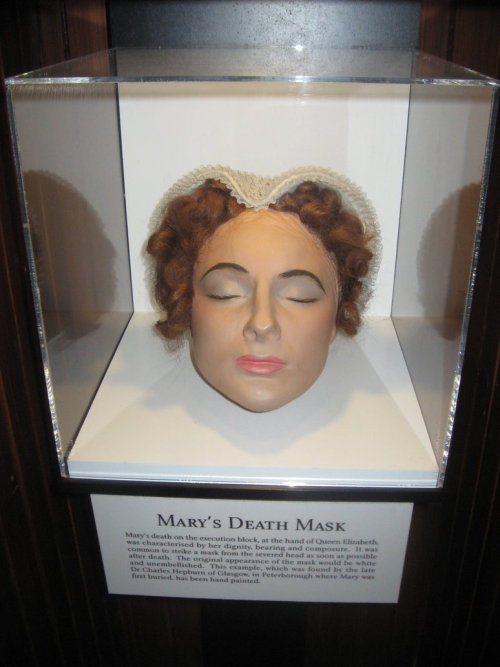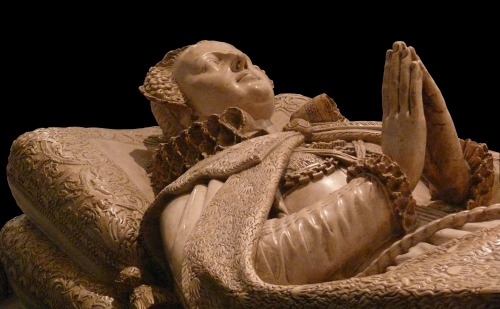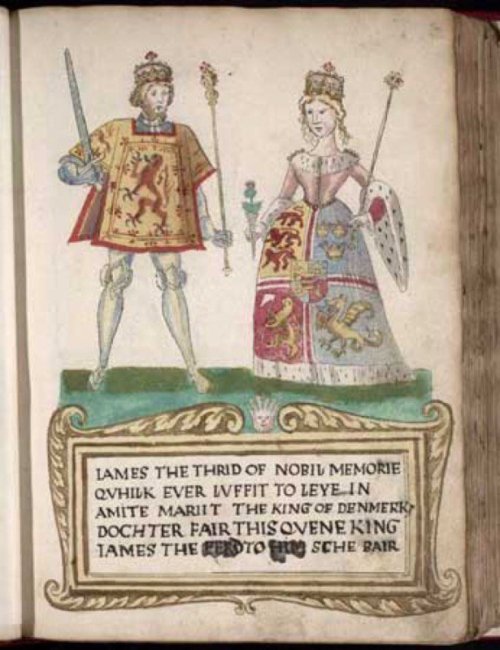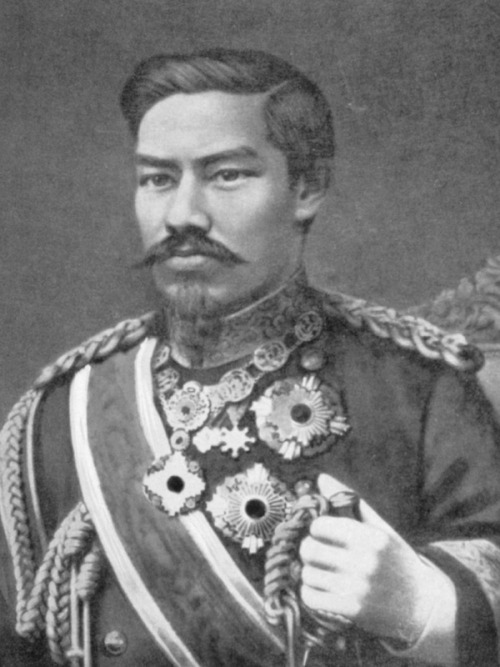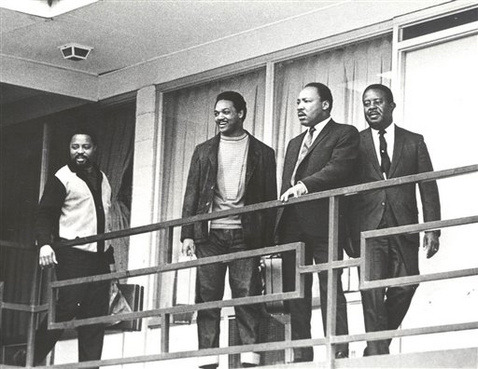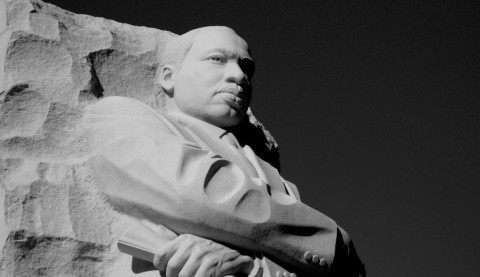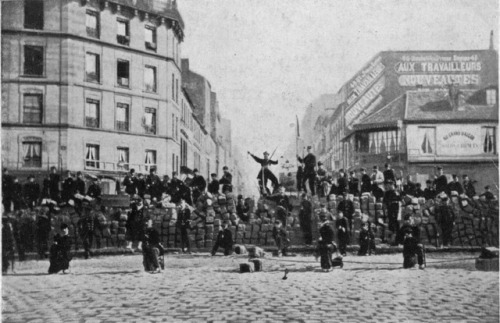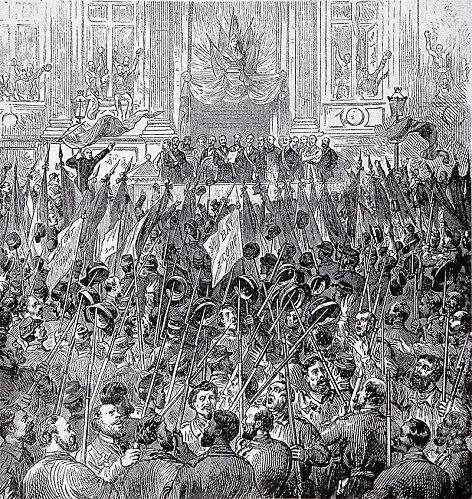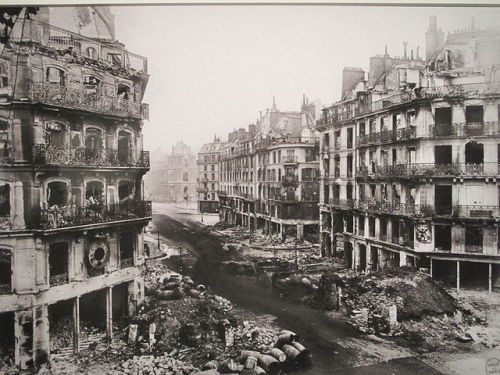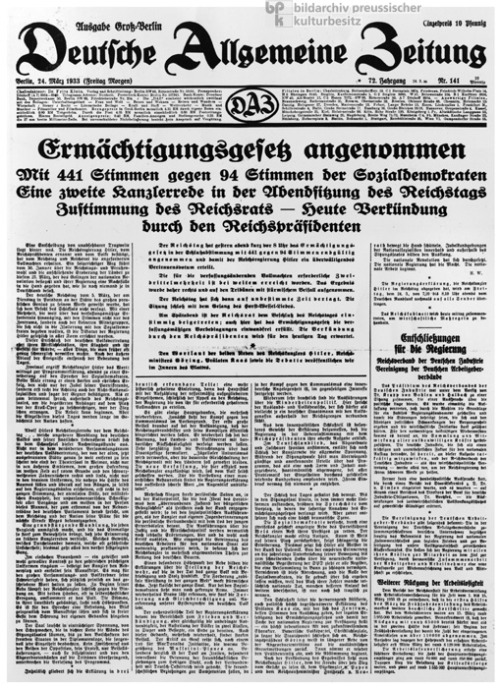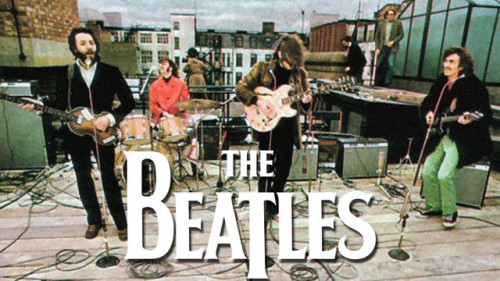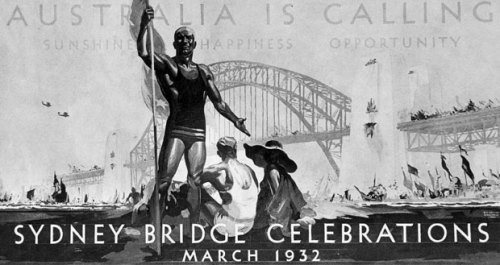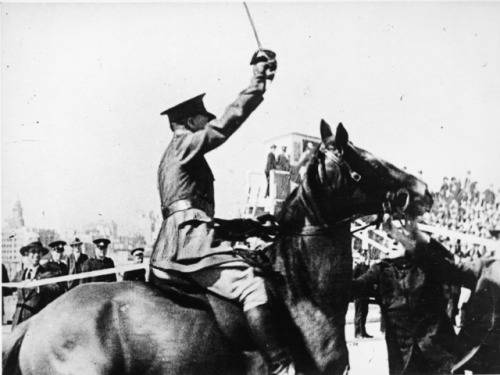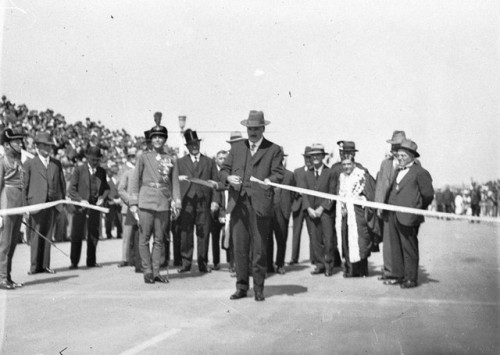#on this day in history
On February 8th 1587 Mary Queen of Scots was beheaded at Fotheringay Castle.
Pierre de Bourdeille, seigneur de Brantome was a member of the French nobility who accompanied Mary during her internment. He provides us with a sympathetic account of Mary’s execution that begins with the arrival of a delegation from Queen Elizabeth announcing that the former Queen of the Scots is to be executed the next day:
“On February 7, 1587, the representatives of the English Queen, reached the Castle of Fotheringay, where the Queen of Scotland was confined at that time, between two and three o'clock in the afternoon. In the presence of her jailer, Paulet, they read their commission regarding the execution of the prisoner, and said that they would proceed with their task the next morning between seven and eight o'clock. The jailer was then ordered to have everything in readiness.
Without betraying any astonishment, the Queen thanked them for their good news, saying that nothing could be more welcome to her, since she longed for an end to her miseries, and had been prepared for death ever since she had been sent as a prisoner to England. However, she begged the envoys to give her a little time in which to make herself ready, make her will, and place her affairs in order. It was within their power and discretion to grant these requests. The Count of Shrewsbury replied rudely:
‘No, no, Madam you must die, you must die! Be ready between seven and eight in the morning. It cannot be delayed a moment beyond that time.’ ” It was that sudden, very little time for Mary to prepare, a brutal way to spend the last few hours on this earth……..Mary spent the rest of the day and the early hours of the next morning writing farewell letters to friends and relatives, saying goodbye to her ladies-in-waiting, and praying.
At 2 am on Wednesday 8 February 1587, Mary Queen of Scots picked up her pen for the last time. Her execution on the block at Fotheringhay Castle was a mere six hours away when she wrote this letter. It is addressed to Henri III of France, brother of her first husband. The letter was written in French, the following is a translation and is a fascinating insight into the mind of our Queen hours before her murder. Mary had only learnt her fate a few hours earlier.
Note, even though she had been forced to abdicate, and had been a prisoner of her cousin for 19 years, she still called herself, Queen of Scotland.
Queen of Scotland
8 Feb. 1587Sire, my brother-in-law, having by God’s will, for my sins I think, thrown myself into the power of the Queen my cousin, at whose hands I have suffered much for almost twenty years, I have finally been condemned to death by her and her Estates. I have asked for my papers, which they have taken away, in order that I might make my will, but I have been unable to recover anything of use to me, or even get leave either to make my will freely or to have my body conveyed after my death, as I would wish, to your kingdom where I had the honour to be queen, your sister and old ally.
Tonight, after dinner, I have been advised of my sentence: I am to be executed like a criminal at eight in the morning. I have not had time to give you a full account of everything that has happened, but if you will listen to my doctor and my other unfortunate servants, you will learn the truth, and how, thanks be to God, I scorn death and vow that I meet it innocent of any crime, even if I were their subject. The Catholic faith and the assertion of my God-given right to the English crown are the two issues on which I am condemned, and yet I am not allowed to say that it is for the Catholic religion that I die, but for fear of interference with theirs. The proof of this is that they have taken away my chaplain, and although he is in the building, I have not been able to get permission for him to come and hear my confession and give me the Last Sacrament, while they have been most insistent that I receive the consolation and instruction of their minister, brought here for that purpose. The bearer of this letter and his companions, most of them your subjects, will testify to my conduct at my last hour. It remains for me to beg Your Most Christian Majesty, my brother-in-law and old ally, who have always protested your love for me, to give proof now of your goodness on all these points: firstly by charity, in paying my unfortunate servants the wages due them - this is a burden on my conscience that only you can relieve further, by having prayers offered to God for a queen who has borne the title Most Christian, and who dies a Catholic, stripped of all her possessions. As for my son, I commend him to you in so far as he deserves, for I cannot answer for him. I have taken the liberty of sending you two precious stones, talismans against illness, trusting that you will enjoy good health and a long and happy life. Accept them from your loving sister-in-law, who, as she dies, bears witness of her warm feeling for you. Again I commend my servants to you. Give instructions, if it please you, that for my soul’s sake part of what you owe me should be paid, and that for the sake of Jesus Christ, to whom I shall pray for you tomorrow as I die, I be left enough to found a memorial mass and give the customary alms.
This Wednesday, two hours after midnight.
Your very loving and most true sister, Mary RTo the most Christian king, my brother-in-law and old ally.
We rejoin de Bourdeille’s account as Mary enters the room designated for her execution and is denied access to her priest:
“The scaffold had been erected in the middle of a large room. It measured twelve feet along each side and two feet in height, and was covered by a coarse cloth of linen.
The Queen entered the room full of grace and majesty, just as if she were coming to a ball. There was no change on her features as she entered.
Drawing up before the scaffold, she summoned her major-domo (steward) and said to him:
‘Please help me mount this. This is the last request I shall make of you.’
Then she repeated to him all that she had said to him in her room about what he should tell her son. Standing on the scaffold, she asked for her almoner, (chaplain) begging the officers present to allow him to come. But this was refused point-blank. The Count of Kent told her that he pitied her greatly to see her thus the victim of the superstition of past ages, advising her to carry the cross of Christ in her heart rather than in her hand. To this she replied that it would be difficult to hold a thing so lovely in her hand and not feel it thrill the heart, and that what became every Christian in the hour of death was to bear with him the true Symbol of Redemption.”
Standing on the scaffold, Mary angrily rejects her captors’ offer of a Protestant minister to give her comfort. She kneels while she begs that Queen Elizabeth spare her ladies-in-waiting and prays for the conversion of the Isle of Britain and Scotland to the Catholic Church:
“When this was over, she summoned her women to help her remove her black veil, her head-dress, and other ornaments. When the executioner attempted to do this, she cried out:
‘Nay, my good man, touch me not!’
But she could not prevent him from touching her, for when her dress was lowered as far as her waist; the scoundrel caught her roughly by the arm and pulled off her doublet. Her skirt was cut so low that her neck and throat, whiter than alabaster, were revealed. She concealed these as well as she could, saying that she was not used to disrobing in public, especially before so large an assemblage. There were about four or five hundred people present.
The executioner fell to his knees before her and implored her forgiveness. The Queen told him that she willingly forgave him and alI who were responsible for her death, as freely as she hoped her sins would be forgiven by God. Turning to the woman to whom she, had given her handkerchief, she asked for it.
She wore a golden crucifix, made out of the wood of the true cross, with a picture of Our Lord on it. She was about to give this to one of her women, but the executioner forbade it, even though Her Majesty had promised that the woman would give him thrice its value in money.
After kissing her women once more, she bade them go, with her blessing, as she made the sign of the cross over them. One of them was unable to keep from crying, so that the Queen had to impose silence upon her by saying she had promised that nothing of the kind would interfere with the business in hand. They were to stand back quietly, pray to God for her soul, and bear truthful testimony that she had died in the bosom of the Holy Catholic religion.
One of the women then tied the handkerchief over her eyes. The Queen quickly, and with great courage, knelt dawn, showing no signs of faltering. So great was her bravery that all present were moved, and there were few among them that could refrain from tears. In their hearts they condemned themselves far the injustice that was being done.
The executioner, or rather the minister of Satan, strove to kill not only her body but also her soul, and kept interrupting her prayers. The Queen repeated in Latin the Psalm beginning In te, Damine, speravi; nan canfundar in aeternum. When she was through she laid her head on the block, and as she repeated the prayer, the executioner struck her a great blow upon the neck, which was not, however, entirely severed. Then he struck twice more, since it was obvious that he wished to make the victim’s martyrdom all the more severe. It was not so much the suffering, but the cause, that made the martyr.
The executioner then picked up the severed head and, showing it to those present, cried out: 'God save Queen Elizabeth! May all the enemies of the true Evangel thus perish!’
Saying this, he stripped off the dead Queen’s head-dress, in order to show her hair, which was now white, and which she had been afraid to show to everyone when she was still alive, or to have properly dressed, as she did when her hair was fair and light.
It was not old age that had turned it white, for she was only thirty-five when this took place, and scarcely forty when she met her death, but the troubles, misfortunes, and sorrows which she had suffered, especially in her prison.”
The account of Pierre de Bourdeille was originally published in 1665 and republished many times thereafter.
To me her execution was one thing, the way she was treated in death another.
The Queen’s body was embalmed, her entrails secretly buried within the grounds, and she then lay in a lead coffin within Fotheringhay Castle for nearly six months! Queen Elizabeth at last ordered her burial, which was to be in Peterborough Cathedral, denying Mary’s request to be laid to rest in France next to her first husband, King François ll. The Burial Register at Peterbotough contains this entry for the year 1587:
The Queene of Scots was most sumptuously buried in ye Cathedral Church of Peterburgh the first day of August 1587 who was beheaded at Fotheringhay Castell the eight of February before.
The Queen’s body was exhumed 25 years later by her son James l and laid in an ornate marble tomb in Westminster Abbey next to her cousins Elizabeth l and Mary Tudor. What remained of the empty tomb in Peterborough Cathedral was destroyed by Oliver Cromwell’s forces in 1643 when they despoiled the building on their way to attack the Royalist garrison at Crowland.
Post link
25 September 1615 ✧ The death of Lady Arbella Stuart
“Arbella’s life seemed to have ended not with a bang, but with a whimper—and that is no finish for a story. It is true she left not obvious legacy: in the most direct sense, her few goods were immediately seized on the privy council’s authority. In the broader sense, her contribution is an elusive matter. And yet, almost four hundred years after her death, she does not live in posterity. Several chains of action and event—genealogical, historical, ideological—make it hard to end her tale in 1615. They are tenuous, amorphous; so much so that to overemphasize any one is to perform the conjurer’s trick of misdirection. To proclaim that this, this, is why she mattered, is to evoke a strong aroma of sawn-up lady. But together the fragments of the kaleidoscope make Arbella Stuart a curiously ubiquitous ghost; one whose presence cannot easily be dismissed, thought she may haunt only the fringes of history.” – Sarah Gristwood, Arbella: England’s Lost Queen
Post link
The wife of James III, Margaret of Denmark died on July 14th 1486 at Stirling.
I could have posted about Margaret yesterday the date of her marriage to King James III, but rather than going over the same ground waited for todays anniversary.
Margaret of Denmark was born on 23rd June 1456 as the daughter of Christian I, King of Denmark, Norway and Sweden, and Dorothea of Brandenburg. She had been named after Queen Margaret I, who had ruled Denmark, Norway and Sweden in her own right. There is very little information on Margaret’s youth.
In 1468, the Scottish embassy to Denmark set out. King James III was in need of a wife. King Christian provided his only daughter with a dowry of 60,000 florins of the Rhine. He couldn’t pay the entire sum at once, so he handed over 10,000 florins and pledged his lands and rights in Orkney and Shetland as security for the rest. The dowry was never paid off in full. In return, James settled upon his future wife Linlithgow Palace, Doune Castle and a third of his royal revenues. The marriage treaty was signed on 8 September 1468.
It was too late in the year for Margaret to travel to Scotland and so her departure was delayed until the next spring. She was brought to Scotland by the King’s brother-in-law, the Earl of Arran and probably met her future husband for the first time shortly before their wedding in the Abbey of Holyrood on July 13th 1469.
They went on progress to the north of Scotland and then settled into a routine of moving between the principal residences of Holyroodhouse, Linlithgow, Stirling and Falkland. Margaret gave birth to their first child on 1t7 March 1473. He was the future James IV. He was followed by the birth of two more sons in 1476 and 1479, called James and John. And yes they named their first two boys James, these Stewarts found a name they liked and stuck to it!
Scottish historians praised the Queen’s beauty, gentleness and understanding and considered her sensible. She was very popular in Scotland. Margaret’s biographer suggested she only had sex with her husband for procreation possibly leading James to seek mistresses. They do not seem to have been on the most affectionate of terms but Margaret seems to have always respected James’ position as monarch. James may have been difficult to deal with.
Margaret was quite the fashionable lady and there are records that she had at least 15 gowns, of them six were black, two were purple and two were crimson.
She probably played an important role in the events of 1482, where James was deprived of his power by his brother for a few months. It was probably Margaret who gave the order to besiege Edinburgh Castle to liberate her husband. After these events, they lived mostly separate lives. Margaret preferred to live at Stirling, while James stayed in Edinburgh.
She became ill during the summer of 1486, the usual rumours of poisoning were circulated at this time but it may have been enemies of James who spread the rumours. She died at Stirling on 14th July that year.aged only 30 years old. Even though they were practically estranged, James was deeply affected by her death and endowed daily masses for her soul. He even sent a supplication to the Pope asking for her to be made a saint.
She is buried at Cambuskenneth Abbey, her husband joined her two years later. It is thought the grave was destroyed during the destructive Reformation years following the discovery of two coffins under the site of the high altar during restoration in 1865 that were believed to contain the remains of the royal couple. Queen Victoria paid for the restoration and marker that is in place there now.
Post link
“She walked forth in fearful beauty” and “seemed unmoved as a stock, not as one who had to defend her cause, but with the bearing of one coming to great honour.”
Lancelot de Carles
Post link



The infant Princess only lived three months. For a whole week Maria Sophia had sat by her cradle without undressing or going to bed, and after the child’s death in the evening she clung to the little corpse all night in a frenzy of despair. The Marquise de Sassenay has related that the French sculptor Prosper d’Epinay was to have done a portrait of the child. ‘One night he was suddenly wakened and told that Francis II wanted him to come at once. He hurried to the Farnese palace, where he found the King in tears. “My child has just died,” he said, “the Queen and I both wish you to make a cast of her face.” Never having practised this special art, d’Epinay went off to find one of the men he usually employed for such work. He could find nobody. Much upset but anxious to grant the King’s wish, he decided to run home and collect the necessary material for making the cast himself. On returning to the Farnese palace he was ushered into a large room dimly lighted. Its only piece of furniture was the cradle in which the dead Princess was lying. The Queen was weeping and praying on her knees, and the King knelt beside her. D’Epinay approached the royal couple and knowing how painful the process was to witness, he begged Francis to retire and escort the Queen from the room during the operation. The King then whispered to his wife, who made a gesture of refusal. D’Epinay insisted that he could not perform his task in the presence of their Majesties, who then decided to withdraw. Alone, the artist applied the plaster and waited for it to dry before removing it; but in his flutter he had forgotten to smear oil over the dead child’s face previously, so that when he wished to remove the plaster he failed. D’Epinay then had a moment of panic, and setting himself astride the cradle to increase his efforts he struggled to make the mask yield. While intent on this tragic task he thought of the parents’ anguish if the face of their child were disfigured by the operation. Mercifully their Majesties were spared this affliction, for eventually the mask yielded and the features remained intact.’ The Princess was buried in the church of Santo Spirito dei Napoletani behind the Farnese palace.
Acton, Harold Mario Mitchell (1961). The Last Bourbons of Naples (1825-1861)
ON THIS DAY, IN 1870, PRINCESS MARIA CRISTINA OF BOURBON-TWO SICILIES DIED AGED THREE MONTHS OLD. She was the only child of the last King of the Two Sicilies, Francesco II, and his wife Queen Marie Sophie (née Duchess in Bavaria). In 1984 her and her parents remains were moved to the Basilica of Santa Chiara, in Naples, and to this day they rest there.
[Giancarlo Giannini as Francesco II and Ornella Muti as Marie Sophie in ‘O re (1989)]


After having been betrothed to Ludwig II, King of Bavaria, Sophie Charlotte married the Duke of Alençon. Her life and its ending may be summed up in these few words: “ She died as nobly as she lived.“
She perished, burnt alive in the terrible catastrophe of the Bazar de la Charité in Paris, in May 1897. The cinematograph was at that time a novel institution, and the operator, with inconceivable clumsiness, set fire to a room above the one in which the bazaar was held. The ceiling was all in flames before any attempt was made to clear the hall. There was a horrible struggle, in which the strongest had the advantage. However, among the men whose brutal selfishness seems to have stifled all chivalrous feeling, there were a few who thought of the Duchess. They hastened to her help, imploring her to escape, even trying to drag her away by force; but she refused. “I shall stay to the last,” she replied. “Save the others first.” Some Sisters of the Order of S. Vincent de Paul would not leave her, determined to sacrifice their lives also, if need be. The Duchess remained standing; the Sisters knelt round her, praying. As the fire drew close to her she loosened her magnificent hair, which covered her like a cloak. And it was so that those who survived the disaster saw her for the last time.
Laurent, Lea (1916).Our Lady Of Belgium (translation by Elisabeth M. Lockwood)
ON THIS DAY, IN 1897, SOPHIE CHARLOTTE, DUCHESS OF ALENÇON (NEÉ DUCHESS IN BAVARIA), DIED IN THE FIRE OF THE BAZAR DE LA CHARITÉ. She was the youngest daughter of Maximilian, Duke in Bavaria, and his wife Princess Ludovika of Bavaria, and therefore a sister of Empress Elisabeth of Austria. She was briefly engaged to her cousin King Ludwig II of Bavaria in 1867, however the King had no interest in marriage at all and eventually called it off. Less than a year later Sophie married Ferdinand d'Orléans, Duke of Alençon, a grandson of Louis Phillipe, the last King of the French. They had two children, Louise and Emmanuel.
In the later years of her life Sophie did plenty of charity work. The Bazar de la Charité was an annual charity event held in Paris since 1885, in which many different items were sold. The tragic accident that set the place on fire in May 1897 took the lives of 126 victims, many of them aristocratic women, the Duchess of Alençon being the most prominent of them. Sophie’s body was so damaged that only her dentist could identify her by her teeth (something unprecedented in France that led to a breakthrough in forensic odontology). Her remains rest in the Chapelle royale de Dreux, the traditional burial place of the members of the House of Orléans.

On the following morning of 10 April, the Mexican deputation, headed by Gutierrez and Hidalgo, were driven in the Archduke’s state carriages from Trieste to Miramar. It was a Sunday when the gardens were open to the public, and they had never been more crowded than on this day. The Mexicans were welcomed with cheers and flowers, a happy change after those winter months of uncertainty and gloom, waiting in a Paris hotel for Maximilian to make up his mind. Count Zichy, the newly-appointed master of ceremonies, conducted them to the state apartments, where Maximilian and Charlotte, the latter spectacularly beautiful in a rose-colored dress and diamond crown, stood surrounded by their household. Maximilian, who as usual was wearing naval uniform, looked so white and strained that his doctor feared that he was going to faint. Beside him on a small table was a parchment roll containing a list of all the Mexican towns which had given their adhesion to the Empire and he kept nervously fingering this roll as if it was the only justification for acceptance. It was again Gutierrez who acted as spokesman, speaking in the name of a country he had not visited for a quarter of a century, rolling off rhetorical phrases in French, which came more naturally than his mother tongue. Maximilian took care to reply in Spanish, which he and Charlotte had learned and mastered in the last two years. Thanks to the decision of the notables of Mexico, he said, he could now justly regard himself as the elect of the Mexican people. This was the first condition he had made when, in October, they had honored him with the offer of the throne. Thanks to the magnanimity of the Emperor of the French, the guarantees he had mentioned at the time of his first visit had also been provided, and he was therefore able to accept the crown and would endeavor, once he was on the throne, to devote himself “heart and soul to work for the freedom, prosperity and greatness of Mexico”.
His speech aroused the greatest enthusiasm. The Mexicans, who had waited so long in suspense, broke into loud cheers, “Long live the Emperor and Empress of Mexico!” And Charlotte, who was now the “Empress Carlota”, raised her proud little head still higher as she acknowledged their homage. Maximilian swore by the Holy Gospels to “assure by all the means in my power the prosperity and well-being of the nation and to defend the independence and integrity of its territory”. As he spoke, the Mexican Imperial Standard was hoisted on the flagstaff and twenty-one cannon shots were fired in salute from the warships anchored in the bay. The Mexican Empire was bom.
Haslip, Joan (1971). The Crown of Mexico: Maximilian and his Empress Carlota
ON THIS DAY, IN 1864, ARCHDUKE FERDINAND MAXIMILIAN OF AUSTRIA WAS PROCLAIMED EMPEROR OF MEXICO. He was the second son of Archduke Franz Karl of Austria and Princess Sophie of Bavaria, and therefore a younger brother of Emperor Franz Josef I of Austria. Maximilian had accepted the crown of Mexico, at that time intervened by France, after being reassured that the Mexicans had voted in favor of establishing a monarchy - although in reality, the voting had been rigged. His position as emperor was unstable from the beginning, since Benito Juarez was still considered the President of Mexico by many and only the presence of French troops in Mexico could guarantee that he stayed in power. Maximilian’s imperial adventure ended up being short lived, since the empire crumbled down only three years later and after being captured by the forces of Juarez he was convicted for treason and executed by a firing squad.

At eight o'clock on the morning of Saturday, 9 April, the Imperial train with Franz Josef on board drew up at the private station at Miramar, where Maximilian was waiting to receive him. The Emperor was accompanied by an impressive retinue: seven Archdukes, including his two brothers, Karl Ludwig and Ludwig Viktor; three ministers, one of them Count Rechberg; the Chancellors of Hungary, Croatia and Transylvania; the Chief of the General Staff and the civil and military governors of Venetia and of Istria, accompanied by a bevy of secretaries and aides-de-camp. But not even Count Rechberg was witness to the private conversation between the two brothers, which lasted for nearly two hours. Officers of the Themis and the Novara, anchored off Miramar, assert that at one time during the interview they saw the Archduke come out on to the terrace and pace up and down in an obvious state of agitation, till he was recalled by one of the Emperor’s aides-de-camp. It was past eleven when the two brothers returned to the state apartments to put the final signature to the “Family Pact”, witnessed by the highest dignitaries of the Empire. And though Maximilian was later to declare that he had been forced to sign under duress, it was noted at the time that not only the Archduke but also the Emperor had reddened eyes, as if he regretted what he had been forced to do.
The “pact” was signed. The naval band playing ouftide the castle struck up “Gott Erhalte Unser Kaiser” and Charlotte, her radiant composure in striking contrast to that of her husband and brother-in-law, came forward to take the Emperor’s arm and lead him into the state banqueting hall. At half past one, Franz Josef was already at the station. The farewells had been formal and correct. But at the moment of boarding the train, he appears to have felt a twinge of tenderness and regret. All the dissensions of the last years, all the bitterness and suspicions were forgotten. He knew only that he was parting, perhaps for ever, from a once-beloved brother. In a voice broken with emotion, he called out, “Maxl”, holding out his arms to embrace him for the last time.Ministers and generals looked away, for both the brothers were in tears.
Haslip, Joan (1971). The Crown of Mexico: Maximilian and his Empress Carlota
ON THIS DAY, IN 1864, ARCHDUKE FERDINAND MAXIMILIAN OF AUSTRIA RENOUNCED TO HIS HEREDITARY RIGHTS IN ORDER TO BECOME EMPEROR OF MEXICO. Archduke Maximilian was the second son of Archduke Franz Karl of Austria and his wife Princess Sophie of Bavaria, and therefore, a younger brother of Emperor Franz Josef I of Austria. Maximilian had been offered the crown of Mexico, at that time under French intervention, assured that the people had voted in favor of establishing a monarchy. Renouncing to his Habsburg rights was the condition that his brother Franz Josef put forward if he accepted the Mexican offer, which he did. When Maximilian signed the deal, he was second in the line of succesion to the throne of the Austrian Empire.
November 9th 1867: Start of the Meiji Restoration
On this day in 1867, the Tokugawa Shogunate handed power back to the Emperor of Japan. Tokugawa Yoshinobu, the 15th shogun, handed power officially to the emperor. This ended the rule of the Tokugawa samurai who had led Japan since 1600 and ushered in the Meiji Restoration, when imperial power was restored in Japan and the country underwent significant modernisation. The following January the emperor made a formal declaration of the restoration of his power and the shogunate was abolished.
Post link

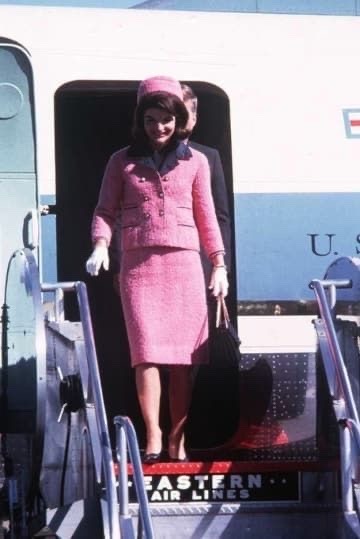


First Lady Jackie Kennedy wore this pink suit to Dallas, Texas on November 22, 1963. While it may or may not be an actual Chanel, Jackie’s suit was one of President Kennedy’s favorites. On the way home from Dallas, Mrs. Kennedy refused to change clothes, reportedly saying, “I want them to see what they have done to Jack.” After the assassination, the suit was later given to Jackie’s mother, Janet Auchincloss. The suit was later given to the National Archives in Maryland, never cleaned. In 2003, Caroline Kennedy deeded her mother’s suit to the Smithsonian on the condition that the suit never be shown in public for at least one hundred years, in 2103. Even then, the Kennedy family will still hold the right to keep the suit, which holds tragic memories for many, kept safely away in a temperature controlled room. The only mystery revolving around the suit is that Jackie’s pillbox hat was never found. Jackie was photographed on other occasions wearing the same suit prior to Dallas, or wearing one very similar to it.









November 8th, 1960: 60 years ago, Senator John F. Kennedy (D-MA) defeated incumbent Vice President Richard Nixon (R-CA) in a closely contested election. Kennedy carried 303 electoral votes in comparison to Nixon’s 219. Kennedy won the popular vote by approximately 112,827 votes. Kennedy became the youngest man to be elected to the office of POTUS. Extra facts about the 1960 election: it was the first election where the incumbent president (Gen. Eisenhower) was ineligible to run for a third term due to the 22nd amendment ratified in 1951. This was also the first election where all 50 states participated in the election and the last when the District of Columbia did not.
17 days later, FLOTUS designate Jacqueline Kennedy gave birth to their third child and first son, John F. Kennedy Jr.
April 4th 1841: President William Henry Harrison dies
On this day in 1841, the 9th President of the United States, William Henry Harrison, died in office. Harrison’s time in office was the shortest of any US President, serving only 32 days. He died of complications from pneumonia which he supposedly caught at his inauguration, held in the middle of winter, as he did not want to look old and so refused to wear a coat. Harrison was the oldest President to take office, aged 68, until Ronald Reagan in 1981. He was succeeded upon his death by his Vice-President John Tyler.
Post link
April 3rd 1968: King’s last speech
On this day in 1968, the American civil rights leader Martin Luther King Jr. made his last speech, the day before his assassination. King was one of many leaders of the Civil Rights Movement for racial equality in America, but became the face of the movement for his non-violent tactics and powerful oratory. In 1963, during the March on Washington, King delivered the crowning speech of the struggle - the ‘I have a dream’ speech. Beyond his role in combating racial inequality, King also focused on tackling poverty and advocating peace, especially during the Vietnam War. In April 1968, King visited Memphis in solidarity with striking sanitation workers. It was at the Mason Temple in this city that he delivered his ‘I’ve Been to the Mountaintop’ speech. The very next day, King was assassinated at his Memphis hotel by James Earl Ray. His final speech was remarkably prophetic, as he appeared to acknowledge he would not live long. King, a Baptist minister, invoked the Biblical story of Moses, who led the Israelites out of slavery in Egypt but died before he could enter the Promised Land.
“Like anybody, I would like to live a long life. Longevity has its place. But I’m not concerned about that now. I just want to do God’s will. And He’s allowed me to go up to the mountain. And I’ve looked over. And I’ve seen the promised land. I may not get there with you. But I want you to know tonight, that we, as a people, will get to the promised land.”
Post link
April 2nd 1982: Argentina invades the Falkland Islands
On this day in 1982, Argentine forces landed on the Falkland Islands and occupied the area, which marked the beginning of the Falklands War. The war was the product of long tensions over who possessed the islands, with Argentina claiming ownership and Britain seeing the islands as British territory. Argentine forces landed on the islands and fought the British Royal Marines at Government House, leading to British surrender and thus Argentina seizing control of the Falklands. British Prime Minister Margaret Thatcher responded by sending a naval task force to attack the Argentinians. The conflict killed 649 Argentinians, 255 Britons and three Falkland Islanders, even though it only lasted 74 days. The war ended with Argentine surrender on 14th June, thus returning the islands to Britain.
Post link
March 31st 1492: Spanish expulsion
On this day in 1492, the joint Catholic monarchs of Spain - Ferdinand and Isabella - issued the Alhambra Decree. This decree ordered the expulsion of all Jews who refused to convert to Christianity from the Spanish kingdoms of Castile and Aragon by July 31st. This measure was pushed for by the monarchs’ adviser Tomas de Torquemada, who spearheaded the Spanish Inquisition aimed at rooting out heresy. Ferdinand and Isabella agreed to the expulsion after successfully completing the reconquista- the unification of Spain under Christian rule - with the conquest of Granada. The majority of the nearly 200,000 Spanish Jews chose to leave the country rather than renounce their religion and culture. Many of these Sephardic Jews moved to Turkey, Africa, and elsewhere in Europe, though they often encountered violence as they tried to leave the country. The Jews who remained became conversos,suffering harassment and mistrust.The policy of religious conformity continued in 1502, when Spanish Muslims were also ordered to convert to Christianity. The Alhambra Decree was formally revoked by the Second Vatican Council in 1968, as part of a general attempt by the Spanish government to make amends for the painful legacy of the expulsion.
Post link
March 30th 1979: Airey Neave killed
On this day in 1979, the Shadow Secretary for Northern Ireland Airey Neave was assassinated by a car bomb aged 63. Neave was elected as a Conservative Member of Parliament for Abingdon in 1953, and in the mid 1970s helped lead the effort to install Margaret Thatcher as party leader. At the time of Neave’s death, the Conservatives were the opposition party to the Labour government of James Callaghan but the Conservatives were poised to win the upcoming election, which would have elevated Neave to the cabinet. Neave was known for his tough, anti-IRA policies, which invoked the ire of republican paramilitary groups in Northern Ireland. As the politician was leaving the House of Commons car park, a bomb attached to his car exploded, and he subsequently died from his injuries. The noise from the explosion could be heard in the Commons, which led to a suspension of proceedings as MPs rushed to the windows to see what had happened. The Irish National Liberation Army claimed responsibility for the murder. The incident occurred at the height of the Troubles, which saw conflict in Northern Ireland over the country’s relationship to Britain.
Post link
March 29th 1879: Battle of Kambula
On this day in 1879, the Battle of Kambula occurred, marking a decisive moment in the Anglo-Zulu War. The war in South Africa began in 1878 after the murder of several British citizens by Zulus and the Zulu king’s refusal to hand over the perpetrators for trial. However, authorities in Britain had long been seeking pretense to launch an assault on the Zulu Kingdom to consolidate British rule in the area. The indigenous Zulu warriors had some initial success against the European invaders, including at the battle of Isandlwana in January 1879, though this victory was offset by defeat at Rourke’s Drift. Wary of the enemy, British forces in the Zulu Kingdom led by Evelyn Wood fortified an area near Kambula. On March 29th the Zulu army launched an attack on the British position, but their advance was halted by a British mounted force. The Zulu forces continued their attack, and 11,000 fighters charged head-on into a hail of British fire. They sustained heavy losses, but the Zulu army successfully exerted pressure on the British stronghold and forced the defenders to retreat. Despite putting up a considerable attack, the Zulu forces were eventually forced to retreat under British fire. The battle was a decisive British victory, with the defenders losing 29 soldiers and the Zulu up to 3,000. Kambula also severely weakened the Zulu forces, allowing the British to ultimately defeat the Zulu and imprison their king in July. British victory spelled the end of the independence of the Zulu nation in South Africa.
Post link
March 28th 1871: Paris Commune declared
On this day in 1871, following elections held two days prior, the Paris Commune was officially proclaimed. The Commune seized power in opposition to the election of a conservative National Assembly February 1871; republican Parisians feared that when they met in Versailles the royalist Assembly would restore the monarchy. When officials of Adolphe Thiers’s government tried to remove the city guard’s cannons as a precautionary measure on March 18th, the people rebelled. The city guard called municipal elections for March 26th, which saw victory for the revolutionaries, who established the Commune to govern the city of Paris. On March 28th, the new government held its first meeting and was formally declared. The Commune immediately set about enacting socialist policies, which included a ten-hour work day, abolition of the death penalty, end of military conscription, banning established religion and promoting female suffrage. They adopted a plain red flag as the flag of the Commune, and envisioned that the situation in Paris would encourage a nationwide revolution. The Commune’s lack of internal organisation left them vulnerable to attack, but the catalyst for retribution came when Communard soldiers killed two French troops. On May 21st, national forces entered Paris through an undefended area, launching a violent campaign of street fighting known as ‘Bloody Week’. Around 20,000 insurrectionists were killed before the Commune fell on May 28th. The government treated the surviving Communards and their supporters ruthlessly - arresting around 38,000 and deporting another 7,000. The Commune became a symbol of socialist revolution in Europe and further abroad, with their supporters lamenting the martyrdom of the Communards.
Post link
March 27th 1958: Khrushchev becomes Soviet Premier
On this day in 1958, Nikita Khrushchev became head of the government of the Soviet Union. Khrushchev served as Premier of the world’s first Communist state from 1958 to 1964. He, along with Lenin and Stalin, are the only Premiers to also have been party leader simultaneously. Under Khrushchev, Russia was partially de-Stalinised, which was a core policy of the Premier who vociferously denounced his predecessor’s dangerous ‘cult of personality’. However, the accession of Khrushchev did not ease the tensions of the Cold War, and during his tenure Russia escalated its space program to compete with the United States in the ‘Space Race’. Russia had successfully launched the first satellite, Sputnik 1, in 1957, but now sought to put a man in space, which they did in 1961. It was also under Khrushchev that the Cold War came the closest to breaking out into fully fledged war, with the Cuban Missile Crisis of 1963. Khrushchev was deposed by party colleagues in 1964 and replaced by Leonid Brezhnev as First Secretary of the Communist Party and by Alexei Kosygin as Premier.
Post link
March 26th 1830: The Book of Mormon published
On this day in 1830, the Book of Mormon was first published at E.B Grandin’s New York bookstore. The founder of Mormonism, Joseph Smith Jr, claimed that he had been visited by an angel called Moroni who told him of ancient writings on golden plates which described people God led to the Western hemisphere before the birth of Jesus. These plates were supposedly found by Smith buried by a tree near his home. Smith said he was told by Moroni to translate the plates into English and publish them. Smith initially struggled to find someone to publish the book as many considered it fraudulent and blasphemous. Smith and his friend Martin Harris began work on translating the Book of Mormon, with Smith dictating by either reading directly or using seer stones placed in a top hat. It took eight men and boys working 12 hours a day, six days a week, for almost eight months to print the initial 5,000 copies, which went on sale in March 1830. The building in New York where the Book of Mormon was first published and sold is now the Book of Mormon Historic Publication Site.
Post link
March 25th 1811: Shelley expelled from Oxford
On this day in 1811, Percy Bysshe Shelley was expelled from the University of Oxford for publishing a pamphlet entitled ‘The Necessity of Atheism’. Shelley is best known as a famous English poet, who was part of a group of fellow prominent writers including his wife Mary Shelley and Lord Byron. As well as being as being an author, Shelley was a radical political activist who advocated non-violent protest. Having begun study at Oxford in 1810, it is often said that he only attended one lecture during his time there. He published several works whilst at university, but it was his atheistic pamphlet which led to his appearance before the College fellows and his eventual expulsion as he refused to deny authorship. ‘The Necessity of Atheism’ argued that people do not choose their beliefs and thus atheists shouldn’t be persecuted. However it is unclear whether Shelley was personally an atheist; he may have instead been an agnostic or a pantheist. Either way, this document is an interesting insight into Shelley’s views and shows how atheism was stigmatised in the early nineteenth century.
“Truth has always been found to promote the best interests of mankind. Every reflecting mind must allow that there is no proof of the existence of a Deity”
Post link
March 24th 1944: The ‘Great Escape’
On this day in 1944, a group of Allied prisoners of war staged a daring escape attempt from the German prisoner of war camp at Stalag Luft III. This camp, located in what is now Poland, held captured Allied pilots mostly from Britain and the United States. In 1943, an Escape Committee under the leadership of Squadron Leader Roger Bushell of the RAF, supervised prisoners surreptitiously digging three 30 foot tunnels out of the camp, which they nicknamed ‘Tom’, ‘Dick’ and ‘Harry’. The tunnels led to woods beyond the camp and were remarkably sophisticated - lined with wood, and equipped with rudimentary ventilation and electric lighting. The successful construction of the tunnels was particularly impressive as the Stalag Luft III camp was designed to make it extremely difficult to tunnel out as the barracks were raised and the area had a sandy subsoil. ‘Tom’ was discovered by the Germans in September 1943, and ‘Dick’ was abandoned to be used as a dirt depository, leaving ‘Harry’ as the prisoners’ only hope. By the time of the escape, American prisoners who had assisted in tunneling had been relocated to a different compound, making the escapeees mostly British and Commonwealth citizens. 200 airmen had planned to make their escape through the ‘Harry’ tunnel, but on the night of March 24th 1944, only 76 managed to escape the camp before they were discovered by the guards. However, only three of the escapees - Norwegians Per Bergsland and Jens Müller and Dutchman Bram van der Stok - found their freedom. The remaining 73 were recaptured, and 50 of them, including Bushell, were executed by the Gestapo on Adolf Hitler’s orders, while the rest were sent to other camps. While the escape was generally a failure, it helped boost morale among prisoners of war, and has become enshrined in popular memory due to its fictionalised depiction in the 1963 film The Great Escape.
“Three bloody deep, bloody long tunnels will be dug – Tom, Dick, and Harry. One will succeed!”
- Roger Bushell
Post link
March 23rd 1933: Enabling Act passed
On this day in 1933, the German Reichstag passed the Enabling Act, which essentially secured Adolf Hitler’s position as dictator of Germany. The law gave Chancellor Hitler legal powers to establish his dictatorship as it gave the Cabinet the power to enact laws independently of the legislature - the Reichstag. Its formal name was ‘Law to Remedy the Distress of People and Reich’. Hitler had been appointed Chancellor on January 30th and just before the scheduled election, the Reichstag fire occurred. The Nazis used the incident to suggest a Communist revolution was imminent and passed the Reichstag Fire Decree which suspended civil liberties and habeas corpus. The Nazis failed to gain an absolute majority in the Reichstag, so Hitler drafted the Enabling Act to secure his position. The Nazis pressured and threatened representatives of the Reichstag to pass the bill, positioning SA men and Nazi swastikas in and around the building. With the bill’s passing, Hitler’s dictatorship was assured, and thus began a brutal regime which would last until 1945.
“The authority of the Führer has now been wholly established. Votes are no longer taken. The Führer decides. All this is going much faster than we had dared to hope”
-Joseph Goebbels after the passage of the Act
Post link
March 22nd 1963: ‘Please Please Me’ released
On this day in 1963, the first album by the Beatles, ‘Please Please Me’, was released in the UK by Parlophone Records. The Beatles formed in Liverpool, and made their musical start by performing concerts in Liverpool’s Cavern Club and playing in Hamburg, Germany. The first singles from their debut album, ‘Love Me Do’ and ‘Please Please Me’ had been very successful, with the latter topping the charts in the United Kingdom. The success of their debut album was followed up with their second UK album ‘With the Beatles’ in November 1963. The Beatles went on to become one of the most famous music groups of their day, and its members - John Lennon, Paul McCartney, George Harrison and Ringo Starr - became international icons. The band’s influence continued long after their break up in 1970 and endures to this day.
Post link
March 21st 1960: Sharpeville massacre
On this day in 1960, police opened fire on peaceful anti-apartheid protestors in the South African township of Sharpeville, killing 69. The over 5,000 strong crowd gathered at Sharpeville police station to protest the discriminatory pass laws, which they claimed were designed to limit their movement in designated white only areas. The laws required all black men and women to carry reference books with their name, tax code and employer details; those found without their book could be arrested and detained. The protest encouraged black South Africans to deliberately leave their pass books at home and present themselves at police stations for arrest, which would crowd prisons and lead to a labour shortage. Despite the protestors’ peaceful and non-violent intentions, police opened fire on the crowd. By the day’s end, 69 people were dead and 180 were wounded. A further 77 were arrested and questioned, though no police officer involved in the massacre was ever convicted as the government relieved all officials of any responsibility. The apartheid government responded to the massacre by banning public meetings, outlawing the African National Congress (ANC) and declaring a state of emergency. The incident convinced anti-apartheid leader and ANC member Nelson Mandela to abandon non-violence and organise paramilitary groups to fight the racist system of apartheid. In 1996, 36 years later, then President Mandela chose Sharpeville as the site at which he signed into law the country’s new post-apartheid constitution.
“People were running in all directions, some couldn’t believe that people had been shot, they thought they had heard firecrackers. Only when they saw the blood and dead people, did they see that the police meant business”
- Tom Petrus, eyewitness to the Sharpeville massacre
Post link
March 20th 1852: Uncle Tom’s Cabinpublished
On this day in 1852, American author Harriet Beecher Stowe’s novel Uncle Tom’s Cabin was published. Previously published as a serial in the anti-slavery periodical the National Era, Uncle Tom’s Cabin tells the story of a black slave and recounts the harsh reality of his enslavement. Stowe was an ardent advocate of the abolition of slavery, and wrote the novel in response to the passage of the controversial 1850 Fugitive Slave Act which was part of the Compromise of 1850. The Act ordered Northern citizens to assist in the return of runaway slaves from the South, thus forcing the generally anti-slavery North to become complicit in the continuance of the ‘peculiar institution’. The popular discontent over the slavery issue helped make Uncle Tom’s Cabin the best-selling novel of the nineteenth century and saw its translation into sixty languages. The novel helped keep the flames of anti-slavery sentiment alive, and is therefore sometimes attributed with helping start the American Civil War. While still hailed as a great anti-slavery work of its day, the novel falls short of modern expectations with its stereotypical portrayal of African-Americans.
“So you’re the little woman who wrote the book that started this great war”
- what, according to legend, Abraham Lincoln said upon meeting Stowe in 1862
Post link
March 19th 1932: Sydney Harbour Bridge opens
On this day in 1932, the Sydney Harbour Bridge was opened. There had been discussions of building a bridge to connect the northern and southern shores of Sydney Harbour for years. In 1924, the contract for the bridge was given to English firm Dorman Long and Co. Ltd. and work began on the bridge; work was overseen by J.J.C. Bradfield. There were fears that the two sides of the arch would not align properly, but in August 1930 the two halves met perfectly. Sixteen workers died during construction, most from unsafe working practices. The opening ceremony took place on March 19th 1932, and though the Premier of New South Wales Jack Lang was supposed to cut the ribbon, he was interrupted by an intruder who slashed the ribbon with his sword and declared the bridge open. The man was Francis de Groot, a member of a right-wing paramilitary group who opposed Lang’s leftist policies and the fact that a member of the Royal Family had not been invited to open the bridge. The ribbon was retied and Lang officially opened the bridge. The festivities to mark the opening included floats and a procession across the bridge by members of the public. Thousands of people turned out to see the opening of Sydney Harbour Bridge - a triumph over Depression times.
Post link
March 18th 1314: Jacques de Molay killed
On this day in 1314, Jacques de Molay, the twenty-third and last Grand Master of the Knights Templar, was burned at the stake. The Templar knights were a major fighting unit of the Crusades, aiming to preserve Christendom and regain control of the Holy Land. After control the Holy Land was lost to Muslim forces, support for the Knights Templar started to fade. King Philip IV of France began to mistrust the group and wanted to free himself of his debts to the Templar; he thus had many leading Knights burned at the stake. Pope Clement V disbanded the group in 1312, and the hunt continued for remaining members. The Knights were tortured until they confessed to a range of crimes, including heresy, obscene rituals, and idolatry. De Molay had been forced to make such a confession, and despite retracting the confession, he was charged with heresy and burned at the stake. Pope Clement died a month later and King Philip died that year. With their leader gone, the remaining Templars were arrested or removed from the group and the Knights Templar were no more.
“God knows who is wrong and has sinned. Soon a calamity will occur to those who have condemned us to death"
- De Molay’s words from the stake
Post link


